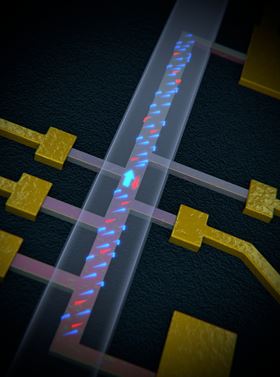 Applying a magnetic field causes current to flow more easily along a topological insulator nanowire in one direction than in the opposite direction. Image: University of Basel, Department of Physics.
Applying a magnetic field causes current to flow more easily along a topological insulator nanowire in one direction than in the opposite direction. Image: University of Basel, Department of Physics.An international group of researchers has demonstrated that wires more than 100 times thinner than a human hair can act as a quantum one-way street for electrons when made of a peculiar material known as a topological insulator.
This discovery opens the way for new technological applications of devices made from topological insulators and demonstrates a significant step on the road to achieving so-called topological qubits, which could offer a means for robustly encoding information for a quantum computer.
To achieve this result, the groups of Jelena Klinovaja and Daniel Loss at the University of Basel in Switzerland closely collaborated with experimental physicists in the group of Yoichi Ando at the University of Cologne in Germany. The researchers report their findings in a paper in Nature Nanotechnology.
Topological insulators are materials in which a combination of quantum mechanics and the mathematical concept of topology produces conductive surfaces and insulating interiors. Topological insulators are highly promising candidates for future technologies and as potential platforms for quantum computing.
In their study, the researchers were able to show that, under the right circumstances, electric currents can flow along a topological insulator nanowire more easily in one direction than the other, a process known as rectification. Rectification has a wide range of applications and forms the basis of most wireless technologies.
The rectifiers found in smartphones, for example, are currently made of semiconductor diodes. However, the rectification effect discovered in topological insulator nanowires arises as a result of quantum mechanics and is extremely controllable.
Usually, quantum rectification effects arise as a result of something known as spin-orbit coupling. This is a strange mix of quantum mechanics and Einstein’s theory of relativity, and normally results in tiny rectification effects.
“What’s great about the topological insulator nanowires is that we can artificially produce essentially the same physics but with a much larger magnitude,” says Henry Legg, a postdoctoral fellow at the University of Basel and first author of the paper. “This leads to a rectification effect that’s really huge compared to other materials. It’s also one of the aspects that makes topological insulators so exciting for applications in quantum computing.”
Ohm’s law states that the current flowing through a device is governed by the voltage drop across it and by a quantity known as resistance. However, when quantum mechanics is at play, Ohm’s law sometimes needs to be corrected.
This is particularly the case if a material or a device does not look the same when all its spatial properties are mirrored – so-called broken spatial inversion symmetry. When a magnetic field is applied to such a material, the quantum version of Ohm’s law allows current to flow more easily in one direction than to the other. The size of this current rectification is determined by the difference between the resistances in each direction.
The high degree of control possible in topological insulator devices allowed the researchers to achieve a truly gigantic rectification effect compared to what had previously been observed.
Quantum computers promise unprecedented computing power, but are very susceptible to the influence of the external environment. One proposed solution to the fragility of quantum units of information – so-called qubits – are topological qubits, which are predicted to be far more stable against the influences of the external environment. This protection also arises as a result of the mathematics of topology that underlies the properties of topological insulators. However, good control over topological insulator devices is essential to be able to produce topological qubits.
“Our study not only discovered a unique and very large quantum effect, but it also shows that we have an excellent degree of understanding what is happening in these systems. It seems like all the key properties of topological insulators are there to move forward on the path to making topological qubits,” says Klinovaja.
This story is adapted from material from the University of Basel, with editorial changes made by Materials Today. The views expressed in this article do not necessarily represent those of Elsevier. Link to original source.